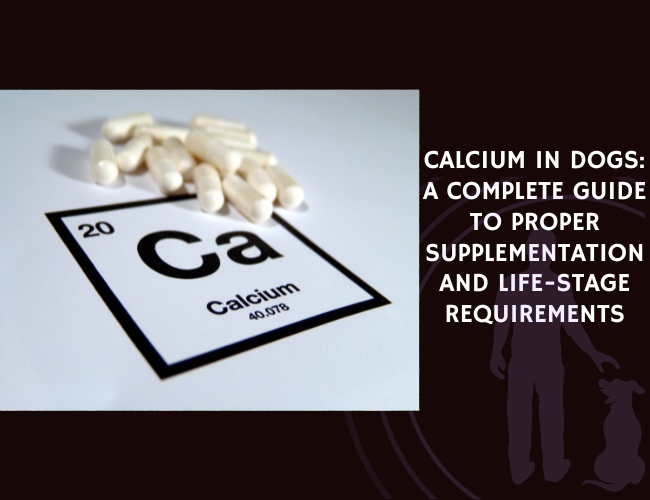Introduction to Calcium in Canine Health
Calcium is an essential mineral that significantly impacts your dog’s health. It plays a critical role in various physiological functions such as bone development, muscle contraction, and blood clotting. Understanding calcium’s importance and properly managing its levels throughout different life stages ensures your furry friend remains healthy and active.
Essential Role of Calcium
Calcium is vital for:
- Bone and Teeth Development: Calcium, combined with phosphorus, forms hydroxyapatite—a mineral complex that gives bones and teeth their strength and structure.
- Muscle Function: This mineral is crucial for muscle contraction. It facilitates the interaction between actin and myosin, the proteins that allow muscles to contract, including the heart muscle.
- Nerve Signal Transmission: Calcium aids in transmitting nerve impulses, ensuring proper communication between the nervous system and muscles.
- Blood Clotting: Known for its role in the coagulation cascade, calcium activates proteins involved in forming blood clots, preventing excessive bleeding.
- Enzyme Activation: Acting as a cofactor for various enzymes, calcium is necessary for hormone secretion and neurotransmitter release, impacting overall metabolic function.
Proper Calcium Management
Proper calcium management is crucial and varies across different life stages:
- Puppies: Growing pups require higher calcium levels (1.2-1.5% of their diet) to support rapid skeletal development and avoid developmental disorders like rickets.
- Adults: Maintenance levels range from 0.5-1.0% of the diet, ensuring bones remain strong and healthy.
- Pregnant and Lactating Dogs: Increased calcium needs (1.5-2.0% of the diet) support fetal development and milk production.
- Seniors: Older dogs need adjusted calcium levels to prevent osteoporosis and maintain joint health.
Maintaining appropriate calcium levels is essential to prevent both deficiencies and excesses. While insufficient calcium can lead to conditions like hypocalcemia, characterized by muscle tremors and weakness, too much calcium might cause hypercalcemia, leading to symptoms such as excessive thirst and potential kidney damage.
Regular veterinary check-ups can help monitor calcium levels and avoid imbalances. By ensuring your dog gets the right amount of this vital mineral, you support their overall health and well-being.
Future chapters will delve deeper into the specific dietary sources of calcium, the importance of the calcium-phosphorus balance, and the health implications of calcium-related disorders.
Physiological Functions and Benefits
Calcium is a powerhouse mineral vital to dog health, contributing to critical functions that keep your furry friend bouncing and happy. Let’s dig into how it shapes up their bones, muscles, and blood clotting processes without making it too complex.
Bone and Teeth Development
Calcium is more than just a bone builder; it’s the architect of your dog’s skeletal framework. This mineral teams up with phosphorus to create hydroxyapatite—a mineral complex that forms the structural foundation of bones and teeth. During growth, ensuring your pup gets adequate calcium prevents bone deformities known as rickets. Maintaining these healthy levels throughout life prevents osteoporosis, a condition that weakens bones as dogs age.
Muscle Function and Nerve Signal Transmission
Muscle function in dogs relies heavily on calcium. This mineral allows for muscle contractions, allowing your pet to chase balls, run around, and even pump their heart [Grano & Zanutto, 2015]. It works behind the scenes, facilitating the interaction between proteins, actin, and myosin, which are responsible for muscle movement. Calcium also plays an unsung role in nerve signal transmission, ensuring that signals sent from the brain reach the muscles. Think of it as the bridge between the brain and body, enabling smooth coordination and reflex actions.
Blood Clotting
Have you ever wondered what stops a small cut on your dog’s paw from bleeding continuously? It’s calcium at work. Calcium is integral to the blood clotting process. It activates several proteins involved in the coagulation cascade, leading to the formation of blood clots. This is vital for preventing excessive bleeding from injuries or surgeries, making calcium an unsung hero in your dog’s circulatory system.
Enzyme Activation
Beyond bones and muscles, calcium is a multitasker acting as a cofactor for various enzymes. It engages in important metabolic processes, including hormone secretion and neurotransmitter release. These functions might sound fancy, but they simply mean that calcium helps the body utilize energy efficiently and respond to stimuli effectively.
Maintaining optimum calcium levels in your dog’s diet helps ensure these physiological functions run smoothly. Remember, imbalances—whether too much or too little—can disrupt these processes and lead to health issues. Regular vet check-ups can help keep your furry friend’s calcium levels in check.
With such an important role in the foundational aspects of canine health, calcium is essential. Next, we will discuss how calcium needs vary at different life stages to support a dog’s health through every phase.
Life Stage-Specific Requirements
Ensuring the right amount of calcium in your dog’s diet is crucial for their overall health and development. The calcium needs of a dog change significantly at different stages of life. Let’s explore the specific requirements for puppies, adults, pregnant or lactating dogs, and senior dogs.
Puppy Requirements
Puppies need higher calcium levels to support their rapid growth and development. The recommended calcium content for puppies is between 1.2% and 1.5% of their diet. This increased requirement is vital for sturdy bone formation and healthy teeth development. Puppies that do not receive enough calcium may suffer from conditions such as rickets, which lead to weak and deformed bones. Given their high-energy needs, it is essential to ensure that their diet is well-balanced and meets the necessary calcium requirements to support their growing bodies.
Adult Maintenance Levels
As dogs transition from puppies to adults, their calcium needs decrease. For adult dogs, maintaining a balanced diet with 0.5% to 1.0% calcium is typically sufficient to keep their bones strong and support overall health. During this stage, it is important to continue monitoring their diet to prevent either deficiency or excess, which could lead to health problems such as osteoporosis or hypercalcemia.
Special Needs for Pregnant and Lactating Dogs
Pregnant and lactating dogs have significantly increased calcium requirements to support both their own health and the development of their puppies. During pregnancy, calcium needs rise to 1.5% to 2.0% of the diet to support fetal development. The demand remains high during lactation to ensure sufficient milk production. Failure to meet these needs can lead to conditions like eclampsia, which is a serious and potentially life-threatening condition caused by low calcium levels.
Senior Dogs
As dogs age, their dietary calcium needs may change again. Senior dogs often require adjusted calcium levels to prevent the weakening of bones and the development of conditions such as osteoporosis. Typically, their calcium needs should be managed carefully, considering factors like joint health and mobility issues that are common in aging dogs. Ensuring the right balance often involves collaborating with a veterinarian to tailor their diet to their age-specific needs.
Regular veterinary check-ups are essential to monitor and adjust calcium levels as necessary. Proper management of calcium intake throughout a dog’s life helps in preventing various health issues and ensuring your canine companion maintains optimal health and quality of life.
By understanding and meeting the life stage-specific calcium requirements, you can help ensure the overall well-being of your dog and support their health at every stage of life.

Dietary Sources and Supplementation
Natural Sources of Calcium
Providing your dog with a diet rich in natural sources of calcium is crucial for their overall health. Here are some excellent options:
- Bone Meal: A rich source of calcium, bone meal is often included in commercial diets and can also be added to homemade meals.
- Dairy Products: Foods like yogurt and cheese are good sources of calcium. However, they should be given in moderation due to their lactose content, especially for dogs with sensitive stomachs.
- Fish: Sardines and salmon, particularly with their bones, are excellent sources of calcium. These can be a tasty and nutritious treat for your dog.
- Leafy Greens: Vegetables like kale and spinach contain calcium, although in less bioavailable forms compared to animal-based sources, making them less effective in meeting your dog’s calcium needs.
Commercial Dog Foods
Most commercial dog foods are formulated to meet the calcium guidelines set by the Association of American Feed Control Officials (AAFCO). These guidelines help ensure that your dog’s diet includes balanced calcium levels, promoting overall health. When selecting commercial dog food, look for products that adhere to these standards to ensure your pet receives the nutrition they need.
Homemade Diets and Supplementation
While homemade diets can be a great way to control what your dog eats, they can lead to nutritional imbalances if not properly formulated. If you choose to prepare your dog’s meals at home, consulting a veterinary nutritionist is essential. They can help you create balanced recipes tailored to your dog’s specific needs.
Calcium Supplements
Calcium supplements may be necessary for dogs with certain health conditions or dietary deficiencies. However, it’s crucial to use these supplements under the guidance of a veterinarian. Over-supplementation can lead to hypercalcemia, a condition characterized by excessively high calcium levels, which can be detrimental to your dog’s health.
To avoid the risks associated with calcium imbalances, maintaining a diet that follows AAFCO guidelines, includes natural sources of calcium, and uses supplements judiciously is key.
Continuing the journey through understanding calcium will help sustain your dog’s vital health functions and overall well-being.
The Calcium-Phosphorus Balance
Maintaining a proper calcium-to-phosphorus ratio is vital for your dog’s overall health. The optimal ratio lies between 1.2:1 and 1.4:1, crucial for avoiding skeletal issues, particularly in puppies and large breed dogs [Andrei & Vasile, 2023; Grano & Zanutto, 2015].
Importance of Balance
Bone Health
Calcium and phosphorus work in tandem to support bone structure. Calcium provides bone strength and rigidity, while phosphorus contributes to the formation of bone tissue. When these minerals are balanced, they enhance the bone’s ability to grow and adapt, which is vital during the growth stages of puppies.
Risks of Imbalance
An imbalance in the calcium-phosphorus ratio can lead to several health issues:
- Excess Phosphorus: This can cause calcium to be leached from the bones, increasing the risk of fractures.
- Excess Calcium: Overabundance of calcium can lead to improper bone growth, joint issues, and developmental orthopedic diseases (DOD), especially in large breed puppies.
Life Stage Considerations
Puppies
For growing puppies, especially large breed ones, it is crucial to manage the calcium-phosphorus balance carefully. Rapid growth can lead to skeletal problems if the diet is imbalanced. A slight excess in calcium might appear beneficial initially but can cause joint and bone issues later [Grano & Zanutto, 2015].
Adults and Seniors
For adult dogs, a stable calcium-phosphorus ratio supports bone maintenance and overall health. Senior dogs need adjusted levels to prevent conditions like osteoporosis. This balance helps maintain bone density and reduces the risk of fractures as they age.
Pregnant and Lactating Dogs
Pregnant and lactating dogs have increased calcium needs to support the developing fetuses and milk production. A balanced intake ensures that both the mother and the puppies receive the required nutrients without causing an imbalance that could lead to other health issues [Andrei & Vasile, 2023].
Special Considerations for Large Breed Puppies
Large breed puppies are particularly sensitive to calcium imbalances. Over-supplementation can lead to DOD, while insufficient calcium can result in weaker bones more susceptible to fractures. It’s crucial to manage their diet to align with their specific growth rates and needs [Grano & Zanutto, 2015].
Ensuring your dog’s calcium and phosphorus levels are balanced is a continuous task that requires diligent monitoring and adjustment based on their life stage and specific needs. This careful management will help prevent many common skeletal issues, promoting a healthy, active life for your dog.
Health Implications and Disorders
Signs and Effects of Calcium Deficiency (Hypocalcemia)
Calcium deficiency, or hypocalcemia, is a significant concern in canine health. It can result from poor diet or conditions such as renal disease. Symptoms of hypocalcemia include:
- Muscle tremors
- Weakness
- Seizures
These symptoms occur due to calcium’s critical roles in muscle contraction and nerve transmission. When levels are low, muscles and nerves cannot function correctly, leading to the aforementioned symptoms. Puppies are especially vulnerable to hypocalcemia, which can cause rickets. This condition leads to soft and deformed bones, resulting in growth issues and deformities if not treated promptly.
Risks of Excess Calcium (Hypercalcemia)
While calcium is essential, too much of it can be harmful, leading to hypercalcemia. This condition can be caused by over-supplementation or diseases like hyperparathyroidism. Symptoms of hypercalcemia include:
- Excessive thirst
- Kidney damage
- Lethargy
Excess calcium can deposit in soft tissues, leading to calcification issues like kidney stones. Large breed puppies are particularly at risk of developmental orthopedic diseases (DOD) when they receive excessive calcium. Managing calcium intake carefully through diet and avoiding unnecessary supplementation is crucial.
Common Calcium-Related Disorders
Rickets
Rickets affects young, growing dogs and is caused by severe calcium deficiency. The bones become soft and deformed because they don’t mineralize properly. Puppies with rickets experience pain and difficulty moving, and their growth can be significantly stunted.
Osteoporosis
Osteoporosis is a condition commonly seen in senior dogs, characterized by weak, brittle bones. It occurs when the bones lose density, making them prone to fractures. Proper calcium intake throughout life can help mitigate the risk of osteoporosis in older dogs. Ensuring an appropriate diet and possibly using calcium supplements under veterinary guidance can be preventive measures.
Eclampsia
Eclampsia is a life-threatening condition mainly affecting lactating females due to low calcium levels. It manifests as restlessness, tremors, and in severe cases, seizures. Immediate veterinary attention, including calcium administration, is critical to managing this condition.
Maintaining appropriate calcium levels is vital for preventing these and other disorders in dogs. Regular veterinary check-ups and careful diet management can ensure your dog stays healthy and avoids these complications. By understanding and addressing calcium needs throughout your dog’s life, you contribute to their overall well-being.
Special Health Considerations
Management for Dogs with Orthopedic Issues
Orthopedic issues in dogs, such as joint and bone problems, demand careful calcium management. Ensuring a balanced calcium-to-phosphorus ratio can effectively support bone health and minimize the risk of developmental orthopedic diseases.
Addressing Calcium Needs
Dogs with orthopedic issues benefit from maintaining adequate calcium levels within their diet. Over-supplementation should be avoided, as it may lead to conditions like hypercalcemia, which can exacerbate skeletal problems.
- Regular veterinary check-ups: Monitoring calcium levels through regular veterinary visits is essential to adjusting dietary plans to support joint and bone health.
- Balanced diet: Include high-quality dog foods formulated to provide balanced nutrition, adhering to the guidelines set by the Association of American Feed Control Officials (AAFCO).
Adjustments for Kidney Disease and Osteoarthritis
Dogs suffering from kidney disease and osteoarthritis have unique dietary requirements, including specific adjustments to their calcium intake.
Kidney Disease
Dogs with kidney disease may require reduced calcium intake due to impaired kidney function. Excessive calcium can lead to calcification of soft tissues, including the kidneys, and worsen the condition.
- Reduced calcium: Limiting calcium-rich foods and supplements can help manage kidney disease effectively.
- Regular testing: Frequent blood tests can monitor calcium and phosphorus levels, ensuring they remain within safe limits.
Osteoarthritis
Calcium intake for dogs with osteoarthritis should aim to improve joint health without exacerbating the condition.
- Joint supplements: Combining calcium with joint supplements such as glucosamine and chondroitin can promote joint health and improve mobility.
- Dietary adjustments: Adjust the dog’s diet under veterinary supervision to ensure it meets their specific health needs while preventing excessive calcium intake.
Preventive Measures and Monitoring Requirements
Preventing calcium-related disorders involves adopting a proactive approach through diet selection and regular monitoring.
Proper Diet Selection
Selecting a complete and balanced diet that meets AAFCO standards can significantly reduce the risk of calcium deficiency and excess.
- AAFCO-approved dog foods: Opt for commercially prepared dog foods that are formulated to meet or exceed AAFCO guidelines, ensuring balanced calcium levels for optimal health.
- Avoiding over-reliance on supplements: Calcium supplements should only be used under veterinary guidance to address specific deficiencies, avoiding potential risks of hypercalcemia.
Monitoring and Regular Check-ups
Regular check-ups are key to ensuring your dog’s calcium levels remain balanced.
- Veterinary visits: Schedule regular veterinary visits to monitor your dog’s health, especially if they have specific health conditions.
- Blood tests: Conduct routine blood tests to check calcium and phosphorus levels, allowing for timely adjustments to the dog’s diet.

By carefully managing calcium intake and ensuring regular health monitoring, you can support your dog’s overall well-being and prevent calcium-related disorders. Understanding your dog’s special health considerations and adjusting their diet accordingly is crucial for maintaining optimal health.
Future Developments and Research
As the understanding of canine nutrition advances, so does the research on calcium requirements and supplementation in dogs. In this chapter, we explore critical areas of ongoing and future research that aim to enhance canine health, focusing on aging dogs, bioavailability of calcium in commercial foods, and breed-specific calcium needs.
Aging Dog Calcium Requirements
Research into the calcium needs of aging dogs is gaining momentum. As dogs age, their calcium requirements change, primarily to prevent osteoporosis and maintain bone health. Scientific studies are examining how these requirements differ significantly from those of younger dogs, focusing on the following aspects:
- Bone Density: Aging dogs often experience a reduction in bone density, making them more susceptible to fractures. Researchers are focusing on the optimal calcium levels needed to maintain bone density and strength in senior dogs.
- Calcium Absorption: Changes in the digestive system of older dogs can affect how well they absorb calcium. Scientists are exploring ways to improve calcium absorption in aged canines, potentially leading to new dietary formulations or supplements.
Advances in Calcium Bioavailability in Commercial Foods
Commercial dog foods are continually evolving to meet the nutritional needs of dogs more effectively. One of the primary areas of focus is improving the bioavailability of calcium, ensuring that dogs can absorb and utilize this essential mineral more efficiently. Key developments include:
- Enhanced Formulations: Manufacturers are working on incorporating highly bioavailable forms of calcium into dog food, which can be more easily absorbed by the canine digestive system.
- Fortified Foods: Some commercial diets are being fortified with additional nutrients that aid in calcium absorption. This includes vitamins D and K, which are known to play crucial roles in bone health.
Breed-Specific Calcium Needs
Calcium requirements can vary significantly among different dog breeds, necessitating breed-specific research. Large and giant breeds, for example, are known to have unique calcium needs due to their rapid growth and larger bone structures. Current and future research efforts aim to achieve:
- Targeted Nutrition: By understanding the specific calcium needs of various breeds, nutritionists can develop targeted dietary plans that cater to the unique growth and health requirements of each breed.
- Preventive Measures: Breed-specific research helps in identifying and preventing breed-related calcium deficiencies and excesses, ultimately reducing the risk of bone and joint disorders.
Ongoing Studies and Innovations
The future of calcium supplementation and dietary management in dogs holds promising advancements. Some ongoing studies and innovations include:
- Gut Microbiota: Researchers are investigating the role of gut microbiota in calcium absorption and metabolism. Understanding this relationship could lead to new probiotic therapies that enhance calcium utilization in dogs.
- Diagnostics: Advances in diagnostic tools are making it easier to monitor calcium levels and detect imbalances early. These tools can provide valuable insights, helping veterinarians tailor calcium management strategies more effectively.
In conclusion, the future of canine calcium research is vibrant and essential for improving overall canine health. Continuous advancements in understanding aging dogs‘ requirements, enhancing calcium bioavailability in commercial foods, and exploring breed-specific needs are vital steps toward optimal canine nutrition.










